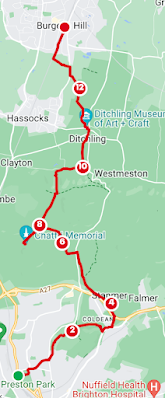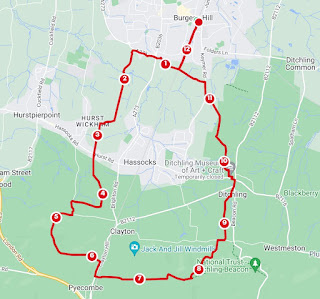In Memoriam
In memory of Mark Burns.
Just bought my ticket and realised my train was cancelled due to an unfortunate person versus train collision. Keen to get underway, I leave the station and take the bus and get off at Preston Park. It's a double decker because it's half term and they've dug this one out of the depot - it smells like a sock left in the washing machine. I used my work pass and so it costs me no more and had the advantage of spitting me out next to my starting point. Brighton and the park are home to the elm trees of The Elm Tree Collection with one reputedly the oldest living in Europe. Elm disease robbed this tree of its 'twin' in 2019 and others have shared its fate including 100 in the Coldean area. Sadly the ash trees have also suffered disease with about 1300 felled in the Stanmer and Moulsecoomb area. Elm trees were useful trees for timber in furniture, coffins and boat building because of their properties. Their form, especially in winter is familiar to me from a childhood in Suffolk.
And it's no wonder my thoughts are of old days. I used to live in Brighton and very close to the park, in a house shared by a few dear old friends. Some things on this walk are solidly here for hundreds, maybe thousands of years but other people, things and moments are fleeting.
From the the bus stop at the the top of Preston Park, enter it and admire what is left of one of the Twin Elms. The diseased tree has been turned into an artwork. The sun blazed through the gilded holes. Make your way on the northern edge and out past the cycle track onto Preston Drove and then left onto Osborne Road. Cross Ditchling Road and a little way north take the footpath through Burstead Woods, past the allotments on your right hand side to to Hollingbury Golf Course, Crossing the road to the club house, take the permitted path through the trees and stick to the waymarked route until you meet the visible ditches of the hillfort. Once there, follow the bank clockwise to bag the trig point. From here you realise what an impressive site this is but it fights for prowess with the sterile fairway. You can see onto The Downs and out to sea. Continue round until the footpath exits the hillfort east. Skirt the green and continue into the trees, ignoring the path on the left.
This is Wild Park and you could probably descend into Moulsecoomb pit but I headed north and turned right on the edge of the trees. Ahead of you is Coldean and beyond you see the Amex Stadium. On your left you see the slightly soviet-looking housing. As you reach Highfields follow it at descend the steps. At the bottom take the path running parallel with Lewes Road, going east. Take the first left, up Coldean Lane and cross opposite the Ruby pub and hotel. Ascend northeast through the Coldean Wood and cross over the the A27.
Now in the Great Wood at Stanmer Park, turn left and head into the trees, going in a roughly northwest direction until you meet Upper Lodges, avoid the tarmac and cross over, continuing north. You'll enter a field with views to The Chattri in the west. At Piddingworth Plantation, you meet Ditchling Road and cross it. Follow the chalk track west and ignore the gate and continue north on the same track. Go round the northern end on New Barn and Join the road at Wonderhill Plantation. You truly are in the heart of the rolling hills here and the house at Lower Standean looks very happy about it. Head towards the house, continue around and past some more barns and just beyond the little wood to where a sign points you in that direction, (ignore the map).
You are guided all the way to the junction with sign to the Chattri. If you're pushed for time, or the mud looks oppressive, you could leave this diversion but why would you? It is a very peaceful spot above Brighton and nice for a flask of tea and a biscuit.
Back on the Sussex Border Path, you'll grind your way steadily northward and upward to the South Downs Way. As you join, go east and you have a choice of bostall, one after the other, to descend towards Ditchling. Note that the paths on the ground differ a little from the map. Just trust the finger posts. Burnhouse Bostall is preferable for a direct route. The other track will deposit you on Underhill Lane from a gravelly track which is hard going on the toes but probably better if it is very wet. Either way, go east on the Lane and continue on the Border path that runs north beside Everflyht. The water coming out of the road flowed directly onto this path and it was a ridiculous muddy river, which I had up until this point largely avoided.
Beyond Molehill Shaw, the path reaches the edge of the houses and over a footbridge. At the roundabout continue between the houses going north. You'll emerge at the junction of South Street and Beacon Road. Take the former. I stopped at the roundabout and the Green Welly for lunch before taking Lewes Road to the front of St Margarets. Cut through the graveyard and down the step towards Ditchling Museum of Art +Craft. Join Lodge Hill Lane and go north to Oldland Windmill. Here I chanced on the in-laws and the lovely dog, which gave me some excellent company as far as the windmill. Go north on Oldlands Lane and join Ockley Lane. Walk swiftly and carefully to the Burgess Hill sign and take the footpath west to the water tower and Batchelor's Farm Nature reserve.
Descending the hill to the railway bridge, remember to wave at trains and make your choices as to whether to go north to the station or west, over the bridge to London Road.
I returned home having had a lovely wander through time and space.


Comments
Post a Comment